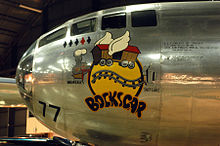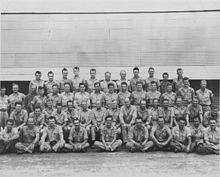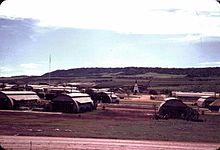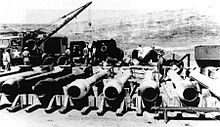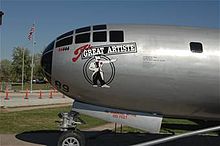509th Composite Group

The 509th Composite Group ( 509 CG ) was a unit of the Twentieth Air Force of the United States Army Air Forces , created specifically for the purpose of atomic bombing during World War II .
The group was formed on December 17, 1944 at Wendover Army Air Field, Utah . The command was Lieutenant Colonel Paul W. Tibbets . The group was self-sufficient and subject to the strictest secrecy. In addition to the B-29 bombers, the 509th also included the 320th Troop Carrier Squadron with C-47 Skytrain and C-54 transport aircraft . The group had its own military police and the crews and technicians were kept strictly separate from the other units on Tinian Island . The manpower amounted to 225 officers and 1542 men and about 50 civilians of the Manhattan Project . The B-29s intended for the dropping of nuclear weapons were so-called silverplate conversions. 18 aircraft were converted, 15 of which were sent to Tinian with their regular crews (see table), four were damaged in accidents, none were lost.
Project Alberta
A part of the Manhattan Project that dealt with the final form of nuclear weapons and their use was designated as Project Alberta . It was clear that only nuclear material would be available for a uranium bomb, so the focus was on plutonium , which was made in Hanford . These test bodies were supplied for the adaptation of the carrier aircraft. At first it was assumed that the plutonium bomb would also use the “ cannon principle ”. The test bombs of the "Thin Man" (Mk2) type were 5.2 m long and therefore did not fit into the bomb bay of a B-29, which was only 3.7 m long. The only aircraft that could accommodate such a weapon was the British Avro Lancaster . So the first Silverplate-B-29 was rebuilt, connected the two bomb bays and provided them with one-piece 10 m long bomb flaps. This first conversion was named "Pullman" and was used extensively for various attempts to drop it. When it became clear that the cannon principle would not work with the plutonium bomb, the "Pullman" was upgraded and a further 17 conversions were initially ordered, which now include the (plutonium) explosion bomb of the Mk.3 " Fat Man " type (3 , 6 m) or the uranium bomb Mk.1 “ Little Boy ” (3.2 m). In February 1945, at a meeting of Oppenheimer, General Leslie R. Groves , James Bryant Conant , Hans Bethe and George Kistiakowski, the final composition of the explosive lenses and the general design of the Fat Man bomb were decided. After the specifications were reasonably clear, various factories began building dummy bombs for testing and training purposes. Experiments were carried out first in Muroc and then in Wendover. From then on the project was in the hands of the 509th and was called Operation Silverplate. The employees of the project, to whom u. A. also belonged to Harold Agnew and Lawrence H. Johnston , were also responsible for building the infrastructure for the 509th in Tinian, so that the bombs could be assembled and loaded there. Some of the group had been on Tinian since May, while others were still working on the Trinity test . After the test, more employees were brought to the Pacific, others accompanied the transport of the plutonium for Fat Man. Lawrence H. Johnston was the only person who witnessed all three atomic bomb explosions (from an airplane) in 1945. Project Alberta director William Sterling Parsons was present at the Trinity Test and aboard the Enola Gay during the attack on Hiroshima.
Preparations
Maj. Paul Tibbets personally selected Wendover Army Airfield for its remote location in the salt flats 150 km west of Salt Lake City. Today the airfield is considered to be one of the best preserved from the Second World War. It is used civilly today and the hall of the "Enola Gay" is still there. Normally, bomber groups trained here to drop bombs and crews were retrained on the new B-29s. When Tibbets visited the airfield, a course was just over and the space was free. The 216th Army Air Forces Base Unit was also available and so Wendover became the home base of the 509th CG. In Wendover, various attempts at dropping the atomic bombs Mk.1 (Little Boy) and Mk.3 (Fat Man) with concrete-filled mock-ups were carried out. The ballistic properties of the test bombs were initially not particularly good and led to several changes to the guide surfaces in order to achieve a stable fall. Work was also carried out on the radar altimeters to detonate the bombs. Various modifications to the bomber's suspension devices also had to be carried out. This was based on the system that the British used for their Tall Boy bombs in the Lancaster bombers. The crews also practiced the procedures for approach and departure with the concrete-filled (so-called pumpkin) bombs, of which a total of 486 were produced, as well as with mockups of the Mk.1. The decisive factor was that the center of gravity of the machine changed significantly after it was dropped, which had to be taken into account during the rapid 155 ° escape maneuver immediately after the bomb was released. At least 50 of the remaining pumpkin casings were taken to the Army Ammunition Plant in McAlester, Oklahoma, and filled with explosives instead of concrete. Then they started their journey to Tinian by sea. After each crew had completed 50 practice drops, Tibbets declared the 509th operational.
Silverplate tags
A total of 46 Silverplate-B-29s were delivered by the Glenn L. Martin Company from the factory near Bellevue / Nebraska (today Offutt AFB ) during the war, further 99 conversions followed until 1951. The machines were not armed with the exception of two MG in the rear stand . The armor was also removed to save weight. Thus the positions of the gunner positions of the normal B-29 were omitted. Instead, an AN / APQ-13 bomb target radar developed from the British H2S was built into the bombers and the crew was supplemented with one or two radar operators.
The normal B-29 had five self-sealing main tanks in the wings , which could hold around 26,200 l (19 t) of fuel. This gave them a range of 5200 km. If required, up to four additional containers could be installed in the bomb bays, each holding 2400 l (1.7 t). During the Silverplate conversions, two of these additional tanks were permanently installed in the rear bomb bay, the Mk.3 plutonium bombs were housed in the front bomb bay. Changes were also made to the bomb doors so that they could be closed faster than usual in order not to offer the expected pressure wave any target.
Distance from Mather AFB in Sacramento (California) to Hickham AFB on Oahu (Hawaii) was about 4000 km, the km from Hickham to Tinian and Saipan around 6000th Thus, the machines with four additional tanks could be transferred to their bases on the Mariana Islands with just one stopover. It can be assumed that the range of the Silverplates significantly exceeded that of the normal B-29s due to weight savings and improved engines, as they could transport the bomb bodies of the Mk.3 bombs to Tinian and thus there was only space for two additional tanks. No. 82 "Enola Gay" differed somewhat from the other machines in that it had to take the Mk.1 uranium bomb, and No. 71 and 72 were initially also equipped for the Mk.1. Maj. Tibbets made a test drop with machine number 71. After the attack on Hiroshima, No. 71 & 72 were immediately converted and flew a few more pumpkin missions. Since the atomic bombs were too big for normal loading, they had to be placed in specially equipped pits, over which the bomber then rolled. There were three such loading pits in Wendover, two in Tinian, and another in Iwojima.
The way to the Pacific
After successful training, the 509th was transferred to Mather Air Force Base in Sacramento / California at the beginning of June 1945 , the flight to Hawaii and finally to Tinian. The transfer flights were carried out individually or in groups, and on June 28, eleven aircraft had arrived. Two more, including No. 82, the later "Enola Gay", followed a few days later. Five of the 18 Silverplate conversions initially remained in Wendover for further drop attempts. Three belonged to the 216th Army Air Forces Base Unit and two to the 509th CG. Although Martin produced further conversions, the 509 initially had a total of 15 machines. Each machine had a permanent crew who usually stayed together.
commitment
In May, the group set up on the North Field on the island of Tinian and, after the arrival of the first machines on June 11, 1945, began 15 more training missions against the Japanese- occupied islands of Truk , Marcus , Rota and Guguan with normal bombs of 454 kg and 907 kg.
Pumpkin bombs
These "exercises" were followed by twelve attacks on Japan with so-called "pumpkin bombs". These continued to correspond in shape and weight to the “ Fat Man ” atomic bomb , but were now filled with 2900 kg of normal explosives . These missions were always carried out with three aircraft to deceive the Japanese air defense about the relative harmlessness of these formations. A total of 49 of these bombs were dropped on July 20, 23, 26 and 29 and on August 8 and 14. One had to be dropped after technical problems, two more could not be dropped. One fell out of its suspension on the ground when it took off and damaged bomber no. 73 in the process. After the drop, the pilots again flew the procedure that had been devised for the atomic bombs and practiced in Wendover. On July 16, 1945, the Trinity test took place and proved the functionality of the complicated plutonium bomb. The simpler uranium bomb hadn't been tested; it was assumed that it would work in any case. There was also not enough fissile 235 U available for a test .
Arrival of the atomic bombs
On July 26, 1945, the cruiser USS Indianapolis reached Tinian with eight empty little boy bombs. (L1-L7 and L11). On July 28, the uranium filling for Little Boy by sea and the plutonium for Fat Man in two C-54s reached the island. On August 2, the B-29s brought nos. 94 and 95, which had been held back in Wendover for this purpose; as well as another B-29 of the 216. three bombs for the Fat Man type. Some of the Little Boy bombs were used by Paul Tibbets for dropping attempts with the B-29 No. 71, others were used for loading exercises in Iwojima and Tinian. L11 was finally equipped with the uranium nuclei.
Final preparations

The Fat Man F31, F32, and F33 cases were re-examined, with F33 showing defects. So F31 was loaded and F32 stored for another attack. It was not until August 4, 1945 that Tibbets and the crews found out what they had been training for. Until then, they had been led to believe that the pumpkins were their main weapon (No. 84 "Some Punkins"). After the real explosive power of the bomb was known from the Trinity test carried out two and a half weeks earlier, fears arose that one of the not infrequent false starts would devastate the entire island. Therefore it was decided, bypassing all command structures, to arm the bomb only during the target approach (→ atomic bombs dropped on Hiroshima and Nagasaki )
Hiroshima
On August 6, 1945, “ Enola Gay ” dropped the “ Little Boy ” bomb over the Japanese city of Hiroshima . Colonel Paul Tibbets was in command, and Captain Robert A. Lewis took on the role of co-pilot in his machine. On board was Captain William S. Parsons , a weapons specialist in the US Navy who was supposed to arm the bomb. Major Charles Sweeney was in command of the escort aircraft, The Great Artiste , and the scientific observers on board were Lawrence H. Johnston , Luis Walter Alvarez and Harold Agnew . Another escort aircraft (No. 91) was flown by Captain George W. Marquardt. Kokura and Nagasaki were intended as replacement targets . Weather surveys over the targets flew No. 71, 83 and 85. As a reserve, No. 72 had previously been flown to Iwojima.
Nagasaki
On August 9, the B-29 called “ Bocks Car ” dropped the “ Fat Man ” atomic bomb on Nagasaki . This time the commanding officer was Major Charles Sweeney . Accompanying aircraft were his "The Great Artiste", this time flown by Captain Frederick C. Bock (the crews had previously exchanged their machines because the measuring devices from August 6th were still installed in the 89), and No. 90 "Big Stink". Other aircraft on this mission were the "Enola Gay", flown by Captain George W. Marquardt, who flew the weather reconnaissance over Kokura, as well as No. 95. This time, the replacement aircraft in Iwojima was No. 83. Sweeny discovered that one of the additional tanks was missing let empty. He tried three approaches to Kokura, but it was always under clouds. He then decided to go to Nagasaki as an alternative destination. Nagasaki was also under clouds. So, contrary to the instructions, Sweenie decided not to drop the bomb on sight, but rather with the radar, which was not particularly accurate at the time, because with the 5.4 t bomb and the 1.7 tonnes of non-removable fuel on board, the aircraft would no longer even have that just conquered Okinawa can reach. He landed in Okinawa with the last drop of fuel, two engines stalled while taxiing. On the same day, No. 71 with crew B-6 and No. 94 with crew A-5 took off back to the USA to pick up the nuclear material for another Mk.3 bomb. It was assumed that the now three reactors in Hanford could produce enough plutonium for another bomb every two to three weeks.
Last missions
Between and after the atomic bombs were dropped, there were other pumpkin bomb attacks. On August 8, six bombers took off and five pumpkins were dropped over Japan. On August 14, 1945, seven B-29s were launched with pumpkin bombs, No. 84 flew the last combat mission of the 20th Air Force. That day, another 800 Twentieth Air Force B-29s were over Japan, accompanied by P-51 Mustangs. On the same day, Emperor Hirohito ordered the surrender of Japan .
Markings
Originally the machines of the 509th carried the symbol “arrow in the ring” on the vertical tail unit and a large number on the rear fuselage. This number later appeared under the front glass. With the exception of the “Enola Gay”, all machines were only given their nose type and name after the attack on Nagasaki. The “arrow in the ring” marking on the vertical stabilizer was also replaced by the badges of other associations during operations to conceal it. “Enola Gay” had an R in a circle, “Bocks Car” an N in a triangle. A total of 60 combat missions were credited to the 509th, 49 with pumpkins and 11 for the use of atomic bombs (six machines over Hiroshima and five over Nagasaki). A fat man with a pumpkin belly in black was attached as a symbol for every pumpkin mission. If the machine was one of the triple formation or a weather plane for the atomic bombing, the symbol was red. No markings were made for the reconnaissance missions above the alternative targets. No. 89 bears two red symbols for its role as escort aircraft for Enola Gay and Bocks Car and then symbols for pumpkin missions.
| serial number | Bow number | Surname | Pumpkin inserts | Commander / crew | Arrival in Tinian |
| B-29-36-MO 44-27296 | 84 | Some punkins | 5 | Captain James N. Price / B-7 | June 14, 1945 |
| B-29-36-MO 44-27297 | 77 | Buckscar | 4 + Fat Man | Captain Frederick C. Bock / C-13 | June 17, 1945 |
| B-29-36-MO 44-27298 | 83 | Full house | 6th | Captain Ralph R. Taylor / A-1 | June 17, 1945 |
| B-29-36-MO 44-27299 | 86 | Next objective | 4th | 1st Lieutenant Ralph N. Devore / A-3 | June 17, 1945 |
| B-29-36-MO 44-27300 | 73 | Strange cargo | 4th | 1st Lieutenant Joseph E. Westover / A-4 | June 11, 1945 |
| B-29-36-MO 44-27301 | 85 | Straight flush | 6th | Captain Claude Eatherly / C-11 | June 14, 1945 |
| B-29-36-MO 44-27302 | 72 | Top secret | 6th | 1st Lieutenant Charles F. McKnight / B-8 | June 11, 1945 |
| B-29-36-MO 44-27303 | 71 | Jabit III | 3 | Captain John A. Wilson / B-6 | June 11, 1945 |
| B-29-36-MO 44-27304 | 88 | Up an 'atom | 4th | Captain George W. Marquardt / B-10 | June 17, 1945 |
| B-29-40-MO 44-27353 | 89 | The great artist | 3 | 1st Lieutenant Charles Donald Albury / C-15 | June 28, 1945 |
| B-29-40-MO 44-27354 | 90 | Big Stink / Dave's Dream | Gilda on 1.7.46 | Lieutenant Colonel Thomas J. Classen / A-5 | June 25, 1945 |
| B-29-45-MO 44-86291 | 91 | Necessary Evil | 5 | 1st Lieutenant Norman W. Ray / C-14 | July 2, 1945 |
| B-29-45-MO 44-86292 | 82 | Enola Gay | Little boy | Captain Robert A. Lewis / B-9 | July 6, 1945 |
| B-29-50-MO 44-86346 | 94 | Luke the Spook | - | Captain Herman S. Zahn / C-12 | August 2, 1945 |
| B-29-50-MO 44-86347 | 95 | Laggin 'Dragon | - | Captain Edward M. Costello / A-2 | August 2, 1945 |
After the war
In November 1945, the 509th Composite Group left North Field in Tinian and was relocated to Roswell Army Air Field, New Mexico. Here the special unit was upgraded to a full-fledged unit and has since been called the 509th Bombardment Group. This was one of the germ cells of the Strategic Air Command . During Operation Crossroads , No. 90, now renamed “Daves Dream”, dropped the bomb “Gilda” on the target fleet anchored in Bikini Atoll . In 1952 the unit was dissolved and only re-established in 1993. The 509th is now the sole operator of the Northrop B-2 . The main base is Whiteman Air Force Base in Missouri .
Relics
Three Silverplate bombers are on public display today:
- "Bock's Car" at the USAF Museum in Dayton Ohio,
- "Enola Gay" at the National Air and Space Museum in Washington and
- a machine painted by "The Great Artiste" in front of Whiteman AFB ( Missouri )
Disassembled or replicated Mk.1 and Mk.3 bombs are shown in various museums. One of each is set up under the “Bock's Car”. On the northern tip of Tinian, the loading pits for the atomic bombs and in Wendover the hangar of the "Enola Gay" can be visited.
Web links
literature
- Stephen Birdsall: Superfortress, the Boeing B-29. Aircraft Specials series, Squadron / Signal Publications, 1980, ISBN 0-89747-104-0
- M. Maurer: Air Force Combat Units of World War II. Office of Air Force History / Maxwell AFB, AL 1983, ISBN 0-89201-092-4

